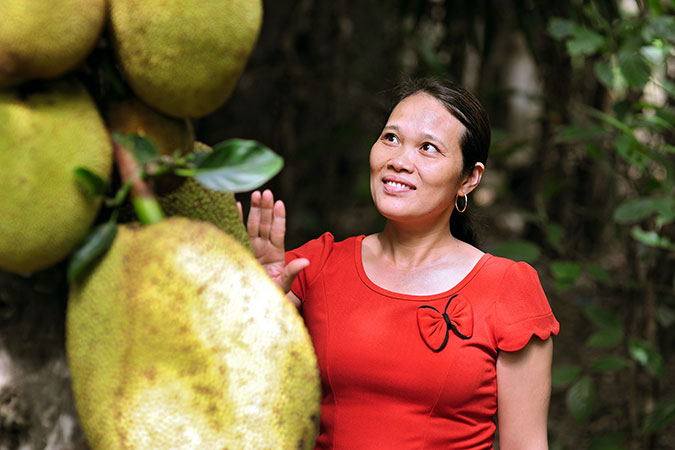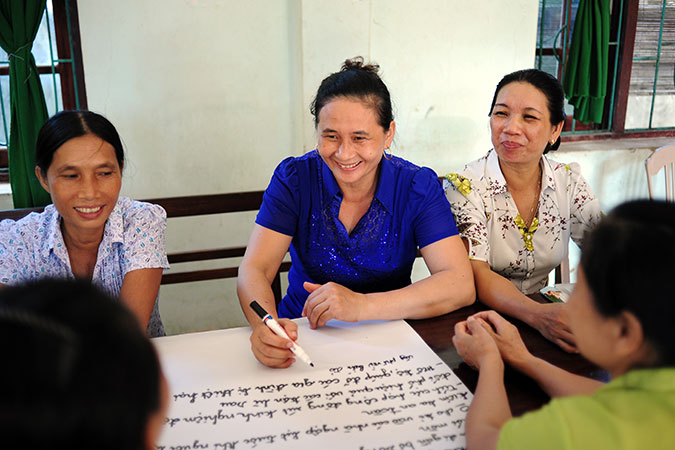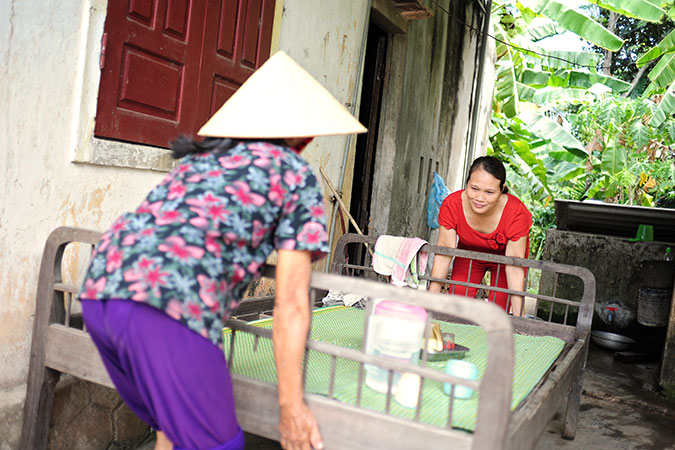In Viet Nam, women are leading disaster prevention and response
Viet Nam ranks among the 12 countries with the highest levels of exposure to natural disasters this year. Until recently, women’s role in disaster risk reduction, preparedness and response was not recognized, which compromised these efforts. With the support of UN Women, local women are now leading their communities in preparing for disasters in ways that reduce negative impacts. When the Kien Giang river flooded last year in the middle of the night, the damage to lives and livelihoods of the people of My Thuy commune was minimal, because of the preparations and adaptations.Date:

Le Thuy district, located along Kien Giang river, is among the high-risk flood zones in Quang Binh province, central Viet Nam. People here are used to gauging the weather patterns from observing the water level. After two years without flooding, in October last year, Le Thuy’s luck turned for the worse—three consecutive floods came within a month.
What you need to know
- Due to women’s roles as care-givers, during natural disasters they are more likely to make sacrifices, such as being the last to leave their house as they help the children and the elderly to a safe place first.
- Disaster damage and loss assessments are seldom disaggregated by sex and are usually recorded in terms of productive resources, which tend to be owned by men. This means, we often underestimate the impact on women.
- An estimated 87 per cent of unmarried women and 100 per cent of married women lost their main source of income when Cyclone Nargis hit the Ayeyarwaddy Delta in Myanmar in 2008 .
- Change is evident. In Viet Nam, a government decree issued in September 2013 provides a space for women to be part of the Committee for Natural Disaster Prevention and Control, making them part of decision-making and planning for actions during the storm season.
- In the My Thuy commune in Viet Nam, community leaders, many of them women, have educated more than 5,000 people about disaster preparedness and response, helping their village to stay safe and reduce negative impacts of floods.
See more facts and figures on women and disaster risk reduction»
"Most of the villagers were sleeping when the flood was rushing in,” recalls Huong Duong, a small shopkeeper living near Kien Giang river in My Thuy commune. “I was woken by the commune loudspeakers warning people that the river water was at a very high level and urging them to help each other to bring their belongings to higher places.” The water flooded Duong’s house very quickly, but luckily, just a little rice that she had left on the floor got wet. Before the flood, she had placed all her furniture and the chickens she raised on higher ground. She had already sold the pigs, in anticipation of the flood season. In her neighbourhood, the damage was minor because of the preparations.
“When I know a storm is coming, I inform the villagers. We help each other to reinforce houses. Some people place sand and stock bags on the roofs to stabilize them. I also remind my neighbours to stock up on food and keep a portable kerosense stove or wood stove handy, so that we can cook without electricity during stormy days,” explains Duong. She is now one of 30 active “communicators” (community leaders in charge of information dissemination) of the My Thuy commune, trained by the Viet Nam Women’s Union and UN Women joint project on disaster risk reduction. Since 2013, the project has reached more than 5,000 people—including men, women, the elderly and children—training and informing them about disaster preparedness and response. In disaster-prone Viet Nam, where according to the government data, on average, 400 lives are lost every year due to climate disasters, the trainings can make a difference of life and death.
"The project has given us the chance to learn how to prepare before the storms come, for example, by harvesting crops earlier, strengthening our shelters, preparing enough food, and storing clean water, lamps, firewood, flashlights and some medicine,” says Ly Nguyen, a local leader from Phong Thuy commune, Le Thuy district. The project also helps the community members in longer-term planning of crops to reduce the impact of disasters on livelihoods: “Some farmers can change from farming bighead carps and dorabs, which need around 10 months to grow, to farming prawns and crabs, which need only two-three months. Others are planting vegetables, such as morning glory, sweet potato or taro, which require shorter time for cultivation. If a storm comes, it does not create huge losses," adds Nguyen.

Through concerted advocacy supported by UN Women and other partners, the leadership of women in disaster management and risk reduction is now recognized and promoted in Viet Nam. A government decree issued in September 2013 provided, for the first time, an official space for the Women’s Union in decision-making boards of the Committee for Natural Disaster Prevention and Control—that means, women like Nguyen and Duong now have a place at the table to make decisions and provide their perspectives for planning actions during the storm season.
"We started at a time when women did not have any formal representation in any of the disaster risk management committees. We are now at a point where Viet Nam Women's Union now is formally the member of the Committees for Natural Disaster Prevention and Control,” says Shoko Ishikawa, UN Women Viet Nam Country Representative. “It goes all the way down to the provinces and the districts. There's a formal acknowledgement that women have a critical role to play in preventing and responding to disasters, which is a victory for us.”

The project, "Strengthening Women's Capacity in Disaster Risk Reduction to Cope with Climate Change”, has been implemented in five provinces of Viet Nam since 2013, including Quang Binh, Ca Mau, Dong Thap, Thua Thien Hue and Binh Dinh, impacting around 5,600 people. It is financed through UN Women core funds and generous contributions by the Government of Luxembourg.